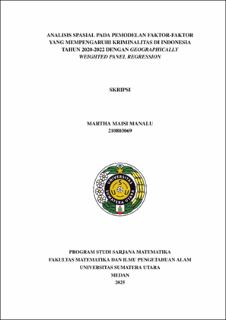Analisis Spasial Pada Pemodelan Faktor-Faktor yang Mempengaruhi Kriminalitas di Indonesia Tahun 2020-2022 dengan Geographically Weighted Panel Regression
Spatial Analysis Of Factors Influencing Crime In Indonesia From 2020 To 2022 Using Geographically Weighted Panel Regression

Date
2025Author
Manalu, Martha Maisi
Advisor(s)
Manurung, Asima
Putri, Mimmy Sari Syah
Metadata
Show full item recordAbstract
Crime is one of the socio-economic issues that remains unresolved in Indonesia.
Although Indonesia is known as a relatively peaceful country, in reality, many citizens
still experience criminal acts. This issue requires immediate attention as it directly
affects public comfort and safety. This study aims to analyze the effectiveness
of the Geographically Weighted Panel Regression (GWPR) method in addressing
spatial heterogeneity when modeling the factors influencing crime rates in Indonesia.
Additionally, it seeks to identify the best model for each province by comparing the
Fixed Effects Model (FEM) and GWPR. The data used cover 34 provinces in Indonesia
over the period from 2020 to 2022. The analytical methods applied include panel
data regression and GWPR. The results show that the GWPR model using an adaptive
Gaussian kernel is the best-performing model, with an R value of 98.61973% and an
AIC of -367.0239. The GWPR model produces different equations for each province,
accompanied by varying statistically significant variables. Overall, there are nine
variables that generally have a significant effect on crime rates: total population, open
unemployment rate, percentage of poor population, average years of schooling, gross
regional domestic product (GRDP), human development index (HDI), percentage of
youth (ages 15–24) not in school, employment, or training, Gini ratio, and the prevalence
of food consumption inadequacy.
Collections
- Undergraduate Theses [1486]
